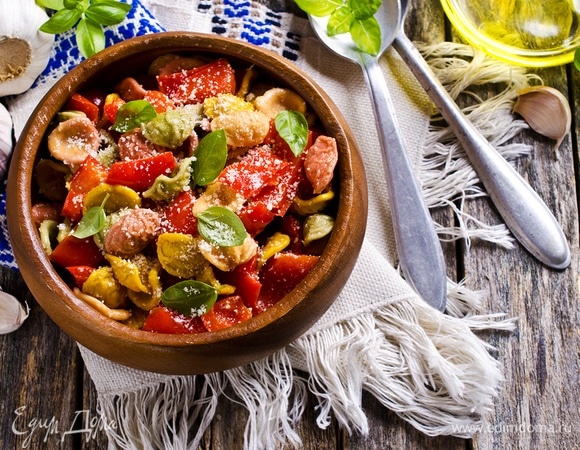
Italian cuisine at home
We associate Italian cuisine with basil, mozzarella, pizza, pasta, tomatoes, tiramisu, parmesan, wine and espresso. Perhaps the Poles can say more about Italian cuisine than about any other. Can he surprise us with something else?
/
Italian regional cuisine step by step
We like to generalize and mix all the ingredients of a given cuisine into one cauldron. It is worth noting that there is no single Italian cuisine and a single approved method of preparing a particular dish. Such things are the norm in Japan, but not in Italy, where each region adapts its ingredients and recipes to its own conditions.
Northern Italy is the land of pasta, polenta and risotto - sticky but firm rice boiled in broth and served with parmesan or vegetables. In addition, pesto with basil, which the Poles love to spread on sourdough bread, comes from here. The cuisine of southern Italy is famous for its Neapolitan pizza, which is a combination of simple ingredients and sincere patience. It also serves lamb and goat dishes.
Sardinia and Sicily are other culinary worlds. The first is famous for its pasta with vegetables and sardines, cannoli for crispy ricotta tubes, granita, which is eaten for breakfast accompanied by a delicate buttery bun, and marzipan figurines that resemble real fruits. Sicily is a paradise for sweet lovers. Sardinia, in turn, tempts with a variety of fish and seafood dishes.
Italy is
Non-obvious tastes of Italy - original dishes and products
* (paragraph for readers with less sensitive stomachs)
Once we saturate our eyes and palate with the recipes offered by Nigella Lawson in Nigellissim's book or Jamie Oliver's book, Jamie Cook in Italian. When we have all the tips and tricks from Bartek Kieżun, aka. Italian Macaronirza we can discover unobvious Italy.
Italy is famous for cheeses. Mozzarella, gorgonzola, parmigiano reggiano, pecorino romano, asiago (my favorite of the Italian cheeses is a little cheese, heat and croutons or vegetables become exceptionally creamy), fontina are classic cheeses that we know well. Of course, we also know mascarpone and ricotta, which are indispensable for perfectly adapted Polish versions of tiramisu and donuts. However, there is a cheese that you rarely hear, that no one imports and that causes the greatest emotions. It's about casu marzu. Now, sheep cheese like Gorgonzola is full of fly larvae that eat cheese and digest proteins. If the larvae are alive, the cheese can be eaten without fear. Dead maggots mean something is wrong with the cheese, and like them, we should stop eating it. For sensitive people, the Sardinians have prepared a variant of cheese tasting without larvae - just put a piece in an airtight bag, and the worms will start to come out on their own. Su Callu is another traditional cheese from Sardinia. Its production is controversial. The kid is fed with mother's milk so that he is really fed, and then quickly killed. The stomach is carefully pulled out, bandaged and dried for two to four months - the milk eaten just before death turns into a delicate cheese.
Spaghetti spoon and Italian cheese grater
Finanziera is a traditional Piedmontese dish that is also not a popular export product. Cockscomb, chicken stomachs and kidneys, pork kidneys, veal brains are fried with a little flour and poured with wine. Cook until a light stew is formed. Cieche fritte - fried tiny eels, almost transparent. They are served with croutons.
In Florence, as in Poland, offal is eaten. When cooking, Italians cut open cow's stomachs and put them in a wheat roll - this is one of the most popular street dishes. You like brownies, don't you? What if the dark color of the cake was not the result of cocoa and chocolate, but of blood? Tuscans do not like to throw away valuable ingredients, so immediately after slaughter, pig blood is mixed with flour, eggs and sugar and baked. One of the greatest delicacies is payata, a dish whose history dates back to the days of Ancient Rome. The stomach of the calf is boiled with its contents until a thick sauce is formed. The stomach can be eaten alone in milk sauce or added to pasta.
What culinary sins can not be committed in Italy?
The first and biggest sin is to order spaghetti bolognese. Italians do not know this dish - they eat bolognese stew. Instead of thin pasta on a plate, we see thick ribbons wrapped in thick meat and tomato sauce.
Secondly, in the morning we only drink cappuccino and latte. Out of poverty, you can order them at noon, but don't let anyone even think about ordering it after your meal. Espresso, only espresso.
Coffee machine MELITTA CI Touch F63-101, 1400 W, silver
Thirdly, pizza. We like hearty pizza - double cheese, ham, pepperoni, mushrooms, tomatoes, corn, a little garlic sauce. Italians eat pizza with extremely thin crust (sometimes more like a tortilla than a cake) with minimal toppings, usually of high quality. Hawaiian with pineapple will not work ...
Fourthly, the breakfast is rather modest. An Italian breakfast is coffee, juice, cookies or a croissant. Sometimes they eat at a bar in their favorite cafe on the street. Hotels, of course, will offer a full range of rich English-style breakfasts. However, this has nothing to do with real Italian food.
Fifth, ketchup. Italians do not pour ketchup on their dishes, even if it is pasta for children. We eat ketchup with french fries. Finito.
Sixth, be careful with Parmesan cheese. We are a little used to sprinkle everything with parmesan cheese - sometimes pizza, sometimes pasta, sometimes toast and tartlets. Meanwhile, hairdressers admit that their dishes are cooked to perfection and there is no need to cover up their taste with the unique but characteristic Parmesan cheese. Sometimes they allow some pecorino...
Container with spoon for CILIO Parmesan
Seventh, bread. The bread often served in Italian restaurants and bars is not meant to be dipped in olive oil. This is the bread that we must leave for the very end, so that we can eat the rest of the sauce from the plate with it. Sounds pretty logical, right?
Eighth, al dente. Chances are high that most Italian pasta will seem undercooked. Al dente is not a soft pasta like strings in broth. Al dente is pasta that resists resistance, in which you can see this very thin strip of undercooked dough. Before a trip to sunny Italy, it is worth cooking pasta at home every time for a minute shorter and getting used to the new consistency. It's also healthier for our stomach!
G3Ferrari G10006 Pizza oven, 1200 W, red
How to cook Italy at home?
If you really want to get into the Italian atmosphere, put a CD of Italian music in your player, pour some wine into a glass and let yourself relax a bit. I highly recommend the Soul Kitchen Italy albums - the first one is energetic music perfect for rolling, slicing and frying. The latter is a little quieter and is ideal for an Italian feast full of flavors and words. In addition, it is worth equipping the kitchen with several gadgets.
The pizza oven design element that I love is the pizza stone. The stone is placed in the oven, heated, and then what we want to bake is placed on us. Thanks to this miracle, we can make a thin, crispy and baked pizza in 2 minutes. The stone is useful for making cakes and bread. It's incredibly heavy and you have to be careful with it, but it's worth the effort.
Pizza stone with feeder JAMIE OLIVER,
As a brilliant student, I always cut frozen pizza with scissors - it was quick and efficient. Now I have a pizza cutter and I think it's a genius invention. He allowed me to cut not only pizza, but also cinnamon yeast dough, shortbread dough for tart, dough for croissants and favourites.
Pasta lovers should get a food processor (it will also come in handy for making pasta dough). Thanks to this, the pasta will turn out the best. If we like ravioli stuffed with ricotta and spinach or prosciutto, we should invest in molds. They can also be used to make crumbly biscuits stuffed with jam.
GEFU pasta machine, silver, 14,4 × 19,8 × 19,8 cm
A tall pot is also useful for cooking spaghetti (and asparagus). You don't have to mix pasta, break it up, or think about how it will fit in the pan. If you like thread-like pasta, a special spoon will help you get it out of the water. There is even a special risotto spoon and risotto plates, but these are probably gadgets for the biggest risotto lovers.
Thaler for risotto MAXWELL AND WILLIAMS Round, 25 cm
Italian cuisine - a simple Italian dish recipe
The easiest pasta cacio e pepe
There is no simpler Italian recipe that demonstrates the importance of good ingredients. In 10 minutes you will prepare a wonderful dish with a touch of piquancy. The most important thing in it is pasta and fresh peppers.
200g fresh spaghetti or tagliolini (you can make your own or find it in the deli section of the supermarket)
4 tablespoons salted butter
1 teaspoon black pepper, freshly ground in a mortar
3 / 4 a glass of grated Parmesan cheese
1) Cook pasta according to package directions. Drain 3/4 cup of water before draining.
2) Heat the butter in a frying pan, add the pepper. Heat for 1 minute with constant stirring.
3) Add boiled pasta, 1/2 cup of water from cooking and parmesan to the pan. Simmer, stirring constantly, until cheese is melted, about 30 seconds. If the pasta is too thick, add the remaining water.
4) Using tongs, divide the pasta into bowls. From these ingredients, we will get two servings of cacio e pepe. Enjoy your meal!
Pasta pot ORION, 4,2 l
What are your favorite Italian dishes? What cuisine would you like to read about?
